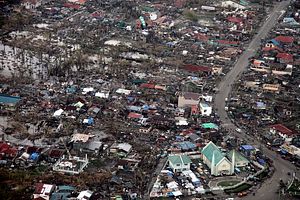While millions of people around the world actively followed the results of the U.S. presidential election on November 8, Filipinos quietly commemorated the third anniversary of Typhoon Haiyan (also known as Yolanda in the Philippines), which killed more than 6,000 people in the central part of the country.
Haiyan was the strongest tropical cyclone to make landfall in history. It caused a tsunami-like storm surge that devastated the islands of Samar and Leyte.
The government’s relief and rehabilitation efforts were criticized as slow and inefficient; many analysts believe this issue was one of the factors that led to the defeat of the administration’s party in the elections earlier this year.
After three years, Haiyan survivors are still seeking aid, justice, and accountability. Their complaints against the haphazard and even anomalous relief distribution program of the previous government were validated by the Department of Social Welfare and Development, which admitted last week that 200,000 survivors were not able to receive emergency assistance in the past three years.
The agency added that the state has failed to deliver on its commitment of rebuilding houses in the Haiyan-affected communities. According to government data, almost 2,000 houses have yet to be constructed despite the allocation of funds for the project.
Some have alleged that corruption and partisan politics are largely to blame for the government’s inadequate recovery efforts.
Even some infrastructure projects were rejected as costly and unnecessary. For example, the construction of a coastal embankment meant to protect residents in disaster-prone areas was opposed by activists because it would displace 10,000 individuals and even possibly harm mangroves and other marine resources.
Meanwhile, the situation in the rural areas has deteriorated. If farmers are still petitioning for state subsidies, it is because many of them are from abaca and rice plantations, which have been attacked by black bugs and stem borers in the past three years.
Haiyan also wiped out thousands of coconut trees in the region, and since it takes seven years before damaged coconut trees can fully recover and be productive again, many farmers are still without a livelihood.
Responding to the petition of Haiyan survivors, Philippine President Rodrigo Duterte has vowed to release funds for the benefit of residents who failed to receive any form of assistance from the state in the past three years. He also instructed agencies to speed up the construction of houses and relocation sites.
When Haiyan struck the Philippines in 2013, it alerted many people around the world to the harsh impact of climate change. Green groups cited the case of the Philippines to highlight the need for urgent action to reduce carbon emissions.
After three years, Haiyan-affected villages continue to suffer from various forms of deprivation. It is a reminder how the deadly mix of poverty and bad governance exacerbate the destructive effect of extreme weather events.
As typhoon victims struggle to rise, many survivors have also realized that it isn’t enough to beg for charity. What Haiyan taught Filipinos is that the most important component of disaster preparation involves the elimination of poverty, inequality, and other forms of economic injustice. To strengthen the capacities of communities, the government should prioritize the stimulation of domestic industries, especially the agricultural sector.
And lastly, the Haiyan anniversary should inspire the Duterte government to rethink the framework of its “war on drugs” by refocusing its strategy to address more urgent, lingering issues like chronic poverty and its causes.

































